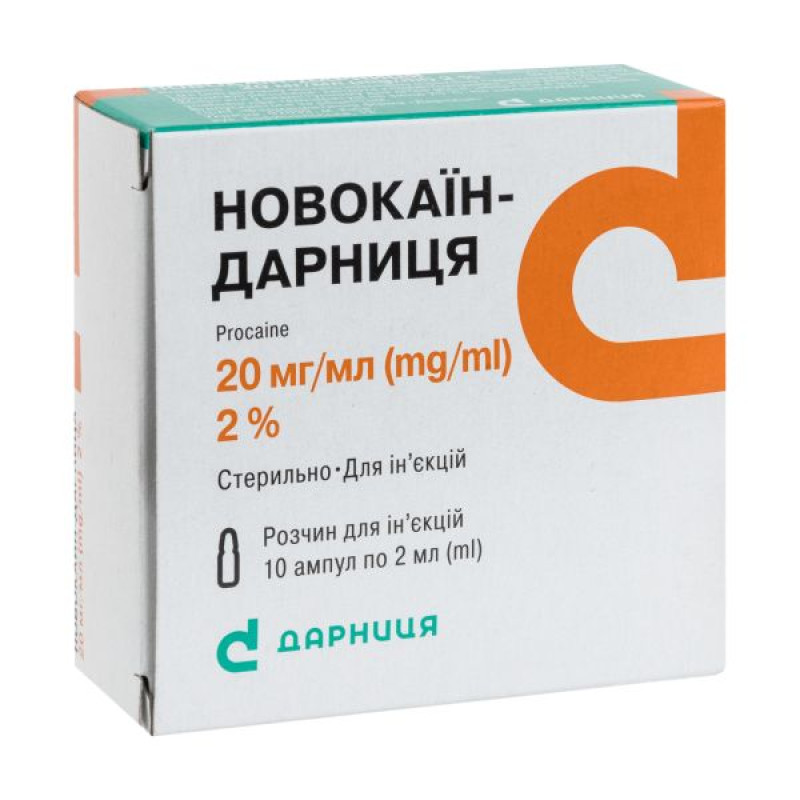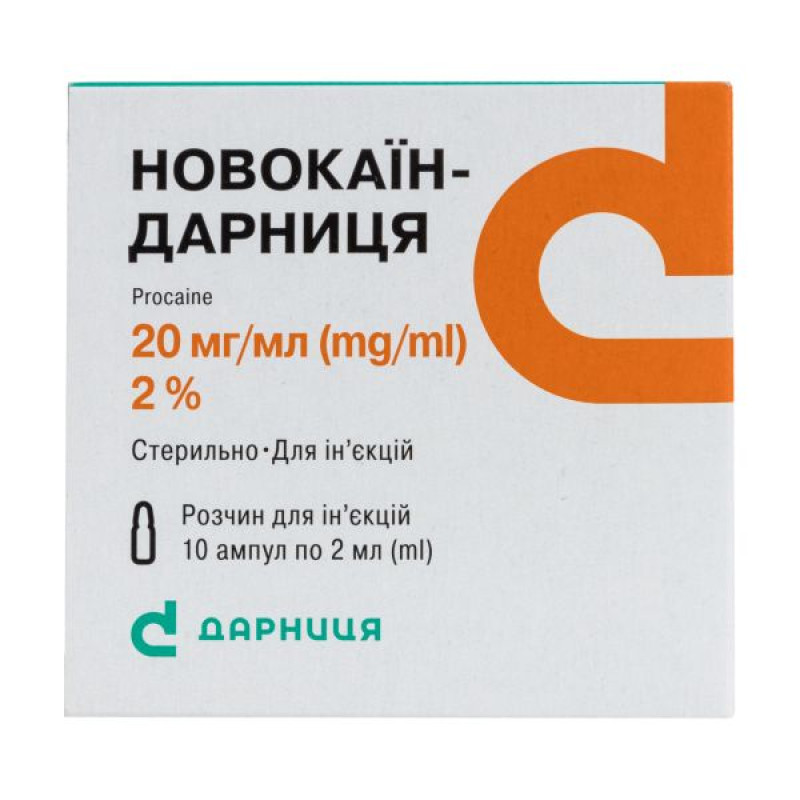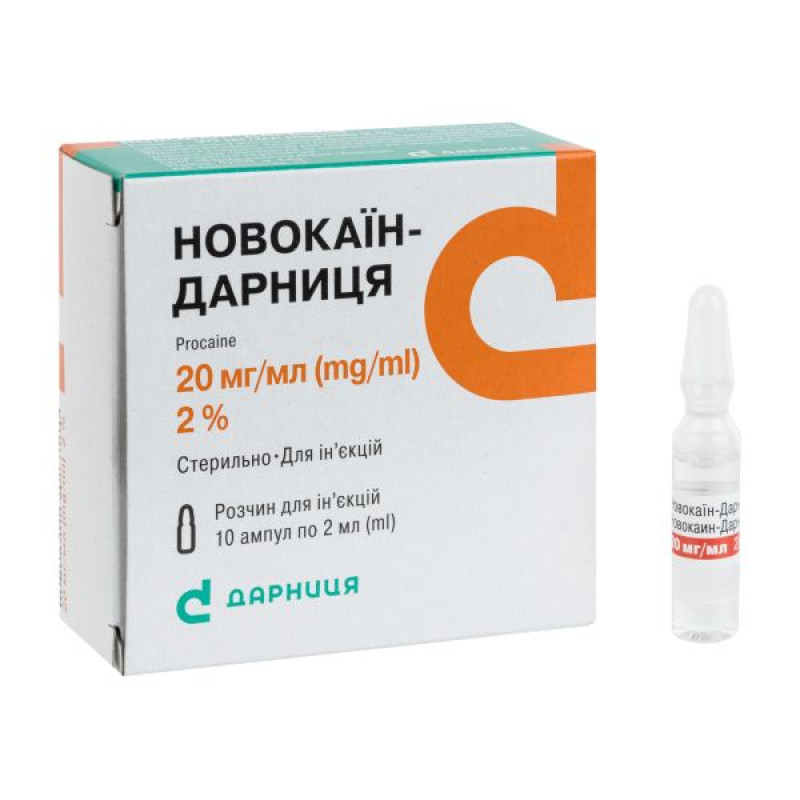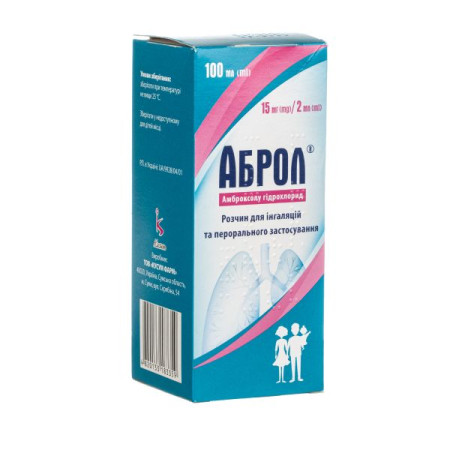Novocaine-Darnitsa solution for injection 20 mg/ml ampoule 2 ml No. 10

Instructions for use Novocain-Darnitsa solution for injection 20 mg/ml ampoule 2 ml No. 10
Composition
active ingredient: procaine;
1 ml of solution contains novocaine (procaine hydrochloride) 20 mg;
Excipients: hydrochloric acid, water for injection.
Dosage form
Solution for injection.
Main physicochemical properties: clear colorless liquid.
Pharmacotherapeutic group
Local anesthetics. Aminobenzoic acid esters. Procaine. ATX code N01B A02.
Pharmacological properties
Pharmacodynamics.
Novocaine is a local anesthetic with moderate activity and a wide spectrum of therapeutic action. The mechanism of anesthetic action is associated with the blockade of sodium channels, inhibition of potassium current, competition with calcium for the surface tension of the phospholipid layer of membranes, inhibition of redox processes and generation of impulses. When entering the blood, it reduces the formation of acetylcholine, reduces the excitability of peripheral cholinergic systems, has a blocking effect on vegetative ganglia, reduces spasms of smooth muscles, reduces the excitability of the cardiac muscle and motor zones of the cerebral cortex.
Pharmacokinetics.
When administered parenterally, it is well absorbed. The degree of absorption depends on the site and route of administration (especially on vascularization and blood flow velocity at the injection site) and the final dose (amount and concentration of the solution). It is rapidly hydrolyzed by esterases and cholinesterases of plasma and tissues with the formation of two main pharmacologically active metabolites: diethylaminoethanol (has a moderate vasodilator effect) and para-aminobenzoic acid (is a competitive antagonist of sulfonamide chemotherapeutic drugs and can weaken their antimicrobial effect). The half-life is 30–50 seconds, in the neonatal period – 54–114 seconds. It is excreted mainly by the kidneys in the form of metabolites (80%); no more than 2% is excreted unchanged. It is poorly absorbed through the mucous membranes.
Indication
Conductive, epidural and spinal anesthesia in surgery, urology, ophthalmology, dentistry, otorhinolaryngology, blockade of peripheral nerves and nerve plexuses.
Contraindication
Hypersensitivity to novocaine; cardiogenic shock; severe arterial hypotension; severe forms of chronic heart failure; reduced left ventricular function; atrioventricular block II–III degree; severe bradycardia; Adams-Stokes syndrome; history of convulsions caused by the use of novocaine; sick sinus syndrome; severe liver dysfunction; hypovolemia; bleeding; myasthenia gravis; infection of the lumbar puncture site; septicemia; purulent process at the site of drug administration; urgent surgical interventions accompanied by acute blood loss. In glaucoma, it is forbidden to administer the drug retrobulbarly.
Interaction with other medicinal products and other types of interactions
Procaine prolongs the neuromuscular blockade caused by suxamethonium (since both drugs are hydrolyzed by plasma cholinesterase).
Concomitant use with monoamine oxidase inhibitors (furazolidone, procarbazine, selegiline) increases the risk of developing arterial hypotension.
The toxicity of procaine is increased by anticholinesterase drugs (inhibiting its hydrolysis). The drug reduces the effect of anticholinesterase drugs on neuromuscular transmission.
The metabolite of procaine (para-aminobenzoic acid) is a competitive antagonist of sulfonamide drugs and may weaken their antimicrobial effect.
Cross-sensitization is possible.
Intravenous administration of novocaine potentiates the effect of anesthetics. When treating the injection site with disinfectant solutions containing heavy metals, the risk of developing a local reaction in the form of soreness and swelling increases.
Potentiates the effect of direct anticoagulants.
Application features
Skin tests with local anesthetics should be performed in individuals with a proven history of reactions to these drugs. Particular care is required when testing local anesthetics containing adrenaline because of the increased incidence of false-negative reactions. It is recommended that skin tests be performed if skin tests are negative. Testing of patients with a proven history of allergic reactions to local anesthetics should only be performed by allergists experienced in the field of drug allergy.
Only medical professionals can administer novocaine.
When local anesthesia of tissues with pronounced vascularization (for example, the neck during thyroid surgery), special care should be taken to avoid the drug entering the vessels.
Smaller doses of the drug should be administered to the head and neck area, including retrobulbar and dental administration, as well as use for stellate ganglion blockade, as systemic toxic effects are possible due to retrograde penetration of the drug into the cerebral circulation.
Care should be taken to avoid accidental subdural or intravasal administration of the drug. Close monitoring of systemic toxicity of the drug on the cardiovascular and central nervous systems is necessary (since the doses prescribed for epidural anesthesia are always higher than for subdural).
Extreme caution should be exercised when performing paraspinal anesthesia in patients with neurological diseases, spinal deformity, septicemia, and severe arterial hypertension.
Before using novocaine for heart diseases (hypokalemia reduces the effectiveness of novocaine), it is necessary to normalize the level of potassium in the blood.
Special caution should be exercised when administering novocaine to patients with circulatory failure, hypovolemia, arterial hypotension, hepatic and renal failure. Caution should also be exercised when prescribing novocaine to elderly patients (over 65 years of age), patients with epilepsy, with impaired cardiac conduction, with respiratory failure, pseudocholinesterase deficiency, seriously ill, debilitated patients, during pregnancy or breastfeeding, and during childbirth.
To reduce systemic effects, toxicity, and prolong the effect of local anesthesia, use novocaine in combination with vasoconstrictors.
Use during pregnancy or breastfeeding
Use during pregnancy is possible provided it is well tolerated.
During breastfeeding, the use of the drug is possible after a thorough assessment of the expected benefit of therapy for the mother and the potential risk to the infant.
When used during childbirth, bradycardia, apnea, and seizures may develop in the newborn.
Ability to influence reaction speed when driving vehicles or other mechanisms
During the treatment period, you should refrain from driving vehicles and other potentially dangerous activities that require increased concentration and speed of psychomotor reactions, due to the possibility of some adverse reactions from the nervous system, sensory organs and/or cardiovascular system (see section "Adverse reactions").
Method of administration and doses
The dose of the drug usually depends on the type of anesthesia, the degree of vascularization of the tissues, the required depth and duration of anesthesia, as well as on the individual characteristics of the patient. The lowest effective dose should be administered.
Recommended doses:
| Type of anesthesia | Novocaine (procaine hydrochloride) | ||
| Solution concentration, % | Solution volume, ml | Total dose of novocaine, mg | |
| Mandibular | 2 | 2–3 | 40–60 |
| Infraorbital | 2 | 0.5–1 | 10–20 |
Finger anesthesia (without adrenaline) | 1* | 3–4 | 30–40 |
Paracervical (in the form of slow 5-minute injections) | 1* | 3 (in each of the 4 areas) | 80–120 |
*To obtain a 1% solution of novocaine, sterile 0.9% sodium chloride solution should be used.
For caudal and lumbar epidural block, 15–25 ml of a 2% solution should be administered. The maximum volume of a single injection should not exceed 25 ml. Repeated doses, usually 2–6 ml less than the initial dose, should be administered at intervals of 40–50 minutes.
The maximum single dose for adults is 11 mg/kg body weight, but not more than a maximum total dose of 800 mg. The dosage should be reduced for the elderly, debilitated patients and patients with cardiovascular and/or liver diseases (see also section "Special instructions").
Children.
The medicine is prohibited for use in children.
Overdose
Overdose is possible only when using novocaine in high doses.
Symptoms: pallor of the skin and mucous membranes, dizziness, nausea, vomiting, increased nervous excitability, "cold" sweat, tachycardia, decrease in blood pressure almost to the point of collapse, tremor, convulsions, apnea, methemoglobinemia, respiratory depression, sudden cardiovascular collapse.
The effect on the central nervous system is manifested by a feeling of fear, hallucinations, convulsions, and motor agitation.
Treatment: In cases of overdose, the administration of the drug should be stopped immediately. When performing local anesthesia, the injection site can be pricked with adrenaline.
General resuscitation measures: oxygen inhalation, if necessary - artificial ventilation of the lungs. If convulsions last more than 15-20 seconds, they should be stopped by intravenous administration of thiopental (100-150 mg) or diazepam (5-20 mg). In case of arterial hypotension and/or myocardial depression, intravenously administer ephedrine (15-30 mg), in severe cases - detoxification and symptomatic therapy.
In the event of intoxication after injection into the leg or arm muscles, a tourniquet should be applied immediately to reduce further entry of the drug into the general bloodstream.
Side effects
The drug is usually well tolerated, however, the following side effects may sometimes develop.
Gastrointestinal: nausea, vomiting, involuntary defecation.
Renal and urinary disorders: involuntary urination.
From the nervous system: headache, motor restlessness, increased irritability, dizziness, drowsiness, weakness, loss of consciousness, convulsions, trismus, tremor, cauda equina syndrome (paralysis of the legs, paresthesias), numbness of the tongue and perioral area, respiratory depression, paralysis of the respiratory muscles, motor and sensory block, return of pain, persistent anesthesia, coma.
Cardiovascular system: chest pain, increase or decrease in blood pressure, collapse, peripheral vasodilation, decrease in cardiac output, bradycardia, arrhythmias, heart block, cardiac arrest.
Blood and lymphatic system disorders: methemoglobinemia.
Immune system disorders: hypersensitivity reactions, including angioedema (including laryngeal edema), other anaphylactic reactions (including anaphylactic shock), urticaria (on the skin and mucous membranes).
Skin and subcutaneous tissue disorders: skin itching, skin rash, dermatitis, skin peeling, eczema, erythema, hyperemia.
General disorders: hypothermia, increased sweating, back pain.
Injection site reactions: when treating the injection site of the drug with disinfectant solutions containing heavy metals, the risk of developing a local reaction in the form of soreness and swelling increases.
Reporting of suspected adverse reactions.
Reporting suspected adverse reactions after the authorisation of a medicinal product is an important procedure. This allows for continued monitoring of the benefit-risk balance of the medicinal product in question. Healthcare professionals should report any suspected adverse reactions via the national reporting system.
Expiration date
3 years.
Storage conditions
Store in the original packaging at a temperature not exceeding 25 ° C. Do not freeze.
Keep out of reach of children.
Packaging
2 ml in an ampoule; 5 ampoules in a contour blister pack; 2 contour blister packs in a pack.
Vacation category
According to the recipe.
Producer
PrJSC "Pharmaceutical Company "Darnitsa".
Address
Ukraine, 02093, Kyiv, Boryspilska St., 13.
There are no reviews for this product.
There are no reviews for this product, be the first to leave your review.
No questions about this product, be the first and ask your question.










